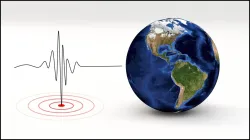Pakistan struck by earthquake of magnitude 5.8, tremors felt in Punjab, Khyber Pakhtunkhwa
Tremors of the 5.8 magnitude earthquake were felt not only in Punjab and Khyber Pakhtunkhwa provinces of Pakistan, but also in Delhi-NCR. No reports of injuries or material damage has been confirmed yet.

Islamabad: Pakistan was hit by an earthquake of magnitude 5.8 at 12:58 pm on Wednesday, according to the National Center for Seismology. The tremors were felt in part of Punjab and Khyber Pakhtunkhwa provinces. No casualties and injuries have been reported. The NCS said the earthquake struck Pakistan at 12:58 pm at a depth of 33 km.
The Pakistan Meteorological Department (PMD) said the earthquake was recorded at a magnitude of 5.7 on the Richter Scale, reported Geo News. The epicentre of the earthquake was situated near the Dera Ghazi Khan region in the southwestern part of Punjab at a depth of 10 km.
The Punjab cities that were jolted by the earthquake included Islamabad, Lahore, Multan, Faisalabad, Mianwali, Bhakkar, Kamalia, Khanewal, Bhalwal, Chiniot, Hafizabad, Toba Tek Singh, Gujarat, Sargodha and Jhang among other cities. In Khyber Pakhtunkwa, the cities of Peshawar, Swat, North Waziristan, DI Khan, Lucky Marwat, Buner, Shangla and Chitral were affected.
This came two weeks after a 5.4 earthquake jolted parts of Islamabad, Rawalpindi and Khyber Pakhtunkhwa on August 29. The earthquake's epicentre was located in the Hindu Kush Region in Afghanistan and it had a depth of 215 kilometres, the PMD stated. This earthquake was preceded by another one of 4.7 magnitude which affected several parts of Islamabad, Rawalpindi and Khyber Pakhtunkhwa in June.
It is pertinent to mention that earthquakes are not uncommon in Pakistan, as the country is situated on the boundary of the Indian and Eurasian tectonic plates. Large parts of South Asia are seismically active because a tectonic plate known as the Indian plate is pushing north into the Eurasian plate.